Kitchens once solved problems we’ve forgotten we even had. You see, post-war homes had spaces barely larger than modern bathrooms, which forced incredible ingenuity from appliance makers. That’s why General Electric created wall-mounted refrigerators that saved precious floor space, and Frigidaire developed flip-top dishwashers to eliminate back-breaking bending. Meanwhile, Ronson tackled cluttered drawers with their multi-tool can openers that worked with Swiss Army knife efficiency.
These vintage solutions reveal what we’ve lost in our rush toward modern convenience.
14. General Electric Americana Refrigerator (1957-1968)

Cramped kitchens plagued post-war homeowners until the General Electric Americana Refrigerator arrived with its ingenious built-in countertop solution. Ever tried preparing a meal in a kitchen the size of a modern bathroom? This solved that problem.
Priced at $425 ($4,200 today), it provided extra space for meal prep. You could chop vegetables directly on your refrigerator without crossing the kitchen. The whole setup worked like Batman’s utility belt – everything within reach when needed.
During the post-war housing boom, families squeezed into smaller homes with limited kitchen space. Betty Wilson of Columbus told Home Journal in 1962: “With three kids underfoot, that countertop saved my sanity during breakfast rushes.”
The model eventually disappeared as kitchens evolved, but its space-saving ingenuity occasionally resurfaces in modern compact designs.
13. Ronson Can Opener (1959-1967)
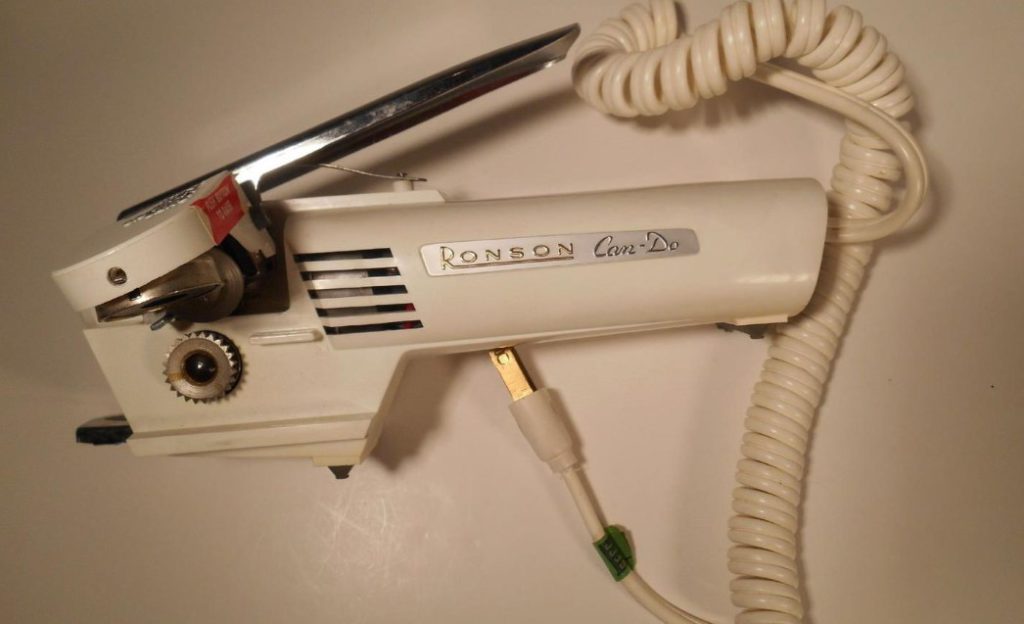
If you owned a small kitchen in the 1950s, the Ronson Can Opener’s multifunctional design combining opener, whisk, masher, and scrambler—saved precious drawer and counter space. During an era when kitchen real estate commanded premium prices, this $19.95 ($190 today) multitasker made perfect sense.
It solved several problems while taking up minimal storage. Kitchen historian Sarah Thompson notes, “The Ronson exemplified mid-century ingenuity—solving multiple problems with elegant design rather than accumulating separate gadgets.”
Can you replace half your kitchen tools with one quirky device? The Ronson tried. (Results varied, especially when bits went missing between uses.)
12. General Electric Wall Refrigerator Freezer (1955-1964)
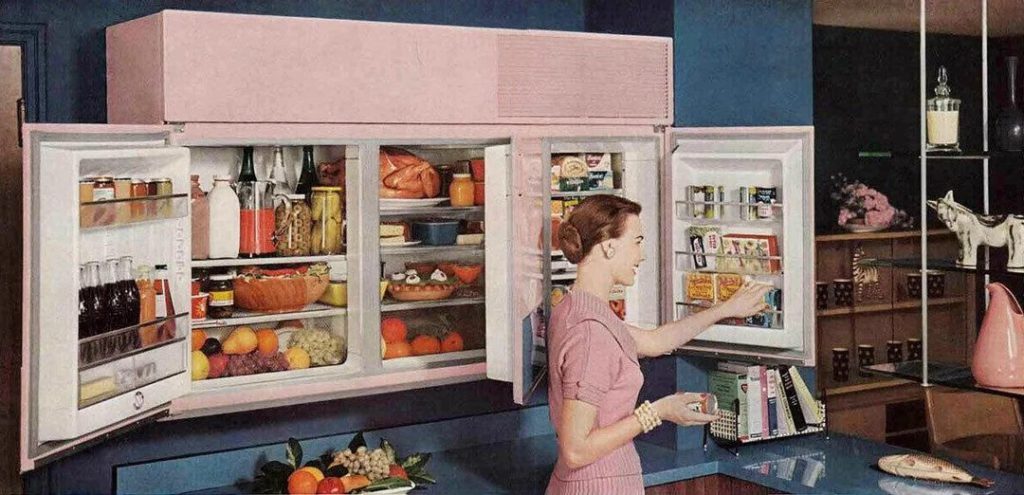
Defying gravity and conventional kitchen design, the General Electric Wall Refrigerator Freezer suspended from your wall like a floating appliance miracle. Priced at $379 ($3,900 today), it solved multiple problems at once. Cleaning underneath became effortless. The elevated position kept treats away from curious toddlers.
Installation required substantial wall reinforcement. You needed seriously robust screws and proper mounting into wall studs. (And probably a prayer that it wouldn’t come crashing down during dinner.)
Trying to install one was like performing surgery while blindfolded – technically possible but fraught with risk.
Though discontinued as standard under-counter models took over, this refrigerator’s 50,000 units sold proved people would try almost anything to save a few square feet of kitchen space.
11. General Electric Revolving Shelves Refrigerator (1963-1972)
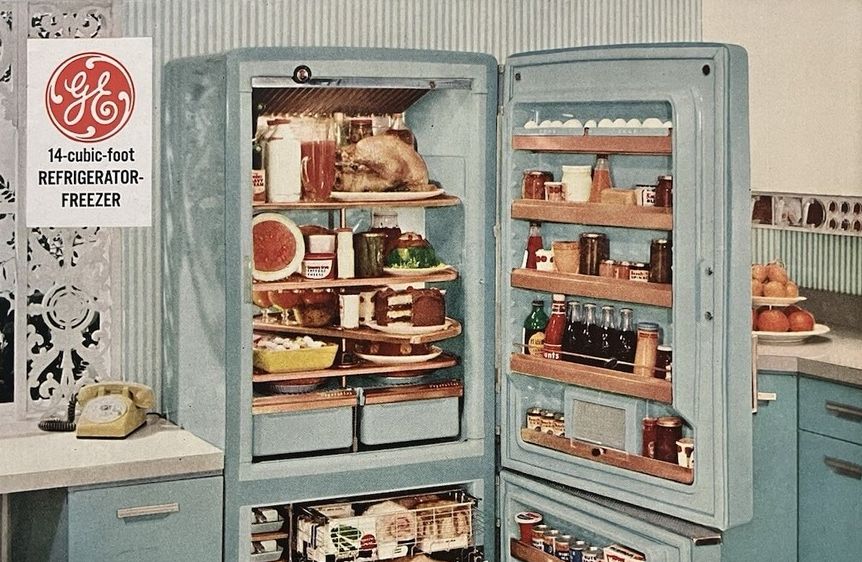
Rotating carousel shelves in the General Electric Revolving Refrigerator brought every item to the front, eliminating forever the frustration of forgotten food lurking in back corners. Selling for approximately $450 ($4,000 today), this innovative design transformed how families accessed their food.
No more knocking over condiments. Forgotten tupperware containers became relics of the past. The rotating design eliminated archaeological expeditions into fridge depths.
The concept addressed a genuine need, though concerns about spills during rotation limited its appeal. It worked about as well as the rotating restaurant in “The Brady Bunch” Hawaii episodes – impressive but slightly impractical.
A GE dealer in Michigan reported customers would spin the shelves repeatedly during demonstrations, often forgetting why they came to the store in the first place.
10. Electric Ice Crusher (1960s-1970s)

When guests arrived for Saturday evening cocktails, the distinctive whir of the Electric Ice Crusher signaled the transformation from ordinary gathering to sophisticated soirée. Priced around $24.95 ($220 today), these devices produced finely crushed ice essential for daiquiris and tiki drinks.
The process transformed ordinary gatherings into special occasions. Just push a button and watch perfectly crushed ice appear – like having a tiny bartender living in your kitchen.
Before electric crushers, people wrapped ice in towels and smashed it with mallets. Messy, inconsistent, and occasionally dangerous! These devices simplified home bartending for anyone who didn’t want their drink preparation to resemble a construction site.
9. Toaster Oven (1960s-Present)
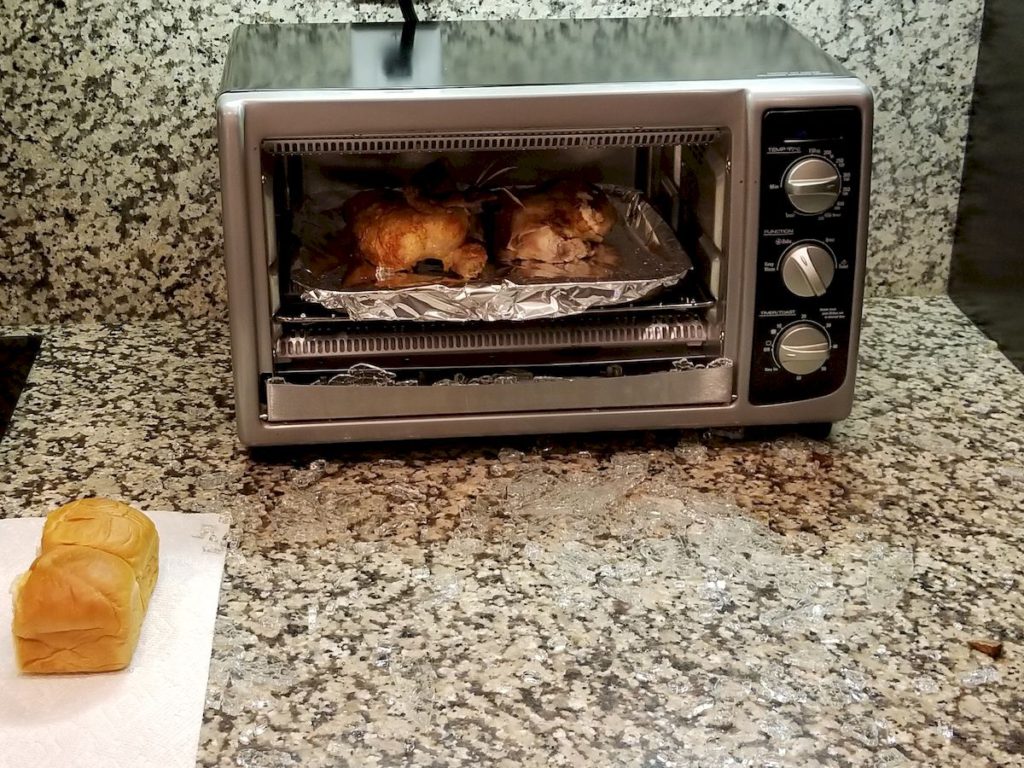
Two appliances merged into one space-saving device with the Toaster Oven, allowing energy-conscious 1970s homeowners to toast, bake, and reheat without firing up energy-hungry full-sized ovens. Over 60% of homeowners in that decade actively sought ways to reduce kitchen energy use.
Priced between $29.95-$59.95 ($280-$560 today), these versatile appliances could toast bread, heat frozen meals, and cook small portions using less electricity than conventional ovens. Their compact size suited various kitchen layouts.
The toaster oven concentrates cooking power like a superhero’s origin story – smaller but often more effective for specific tasks.
Unlike many vintage appliances, the toaster oven continues evolving with convection cooking, digital controls, and air frying capabilities. It remains a kitchen essential for both practical and nostalgic reasons.
8. Coffee Percolator (1920s-1970s)
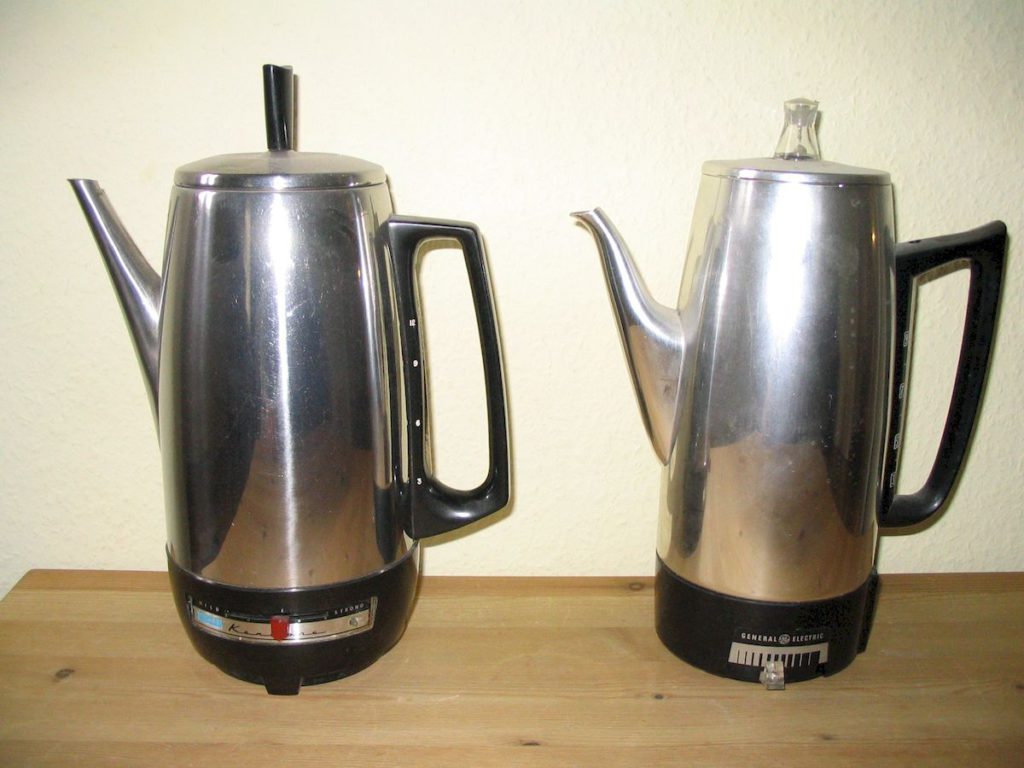
As dawn broke in mid-century America, the gentle gurgling of Coffee Percolators provided the soundtrack to morning routines, producing a robust brew that defined the American coffee experience for generations. These devices circulated near-boiling water through coffee grounds for a distinctively strong flavor.
Ranging from $12.95 for basic models to $39.95 for premium versions ($120-$370 today), percolators were showcase items with ornate designs in copper, chrome, or colorful enamel that users proudly displayed.
Getting the perfect percolator coffee required the timing precision of a bank heist – remove it too soon and the coffee was weak, too late and it turned bitter.
Coffee historian Mark Peterson explains, “The percolator’s reign ended when automatic drip makers promised ‘better’ flavor. However, the craft coffee movement has revived interest in percolation’s bold profile.” The distinctive gurgling sound still triggers nostalgia in anyone who grew up with these brewing contraptions.
7. Space Heater (1950s-1960s)

During the mid-20th century when central heating remained a luxury, Space Heaters became portable saviors for families seeking warmth on demand in specific rooms rather than heating entire homes. These self-contained units transformed cold corners into cozy havens with the flip of a switch.
Priced between $12.95-$39.95 ($130-$400 today), these devices featured a quirky mix of retro aesthetics and practicality. Some models resembled small spaceships with their chrome accents and futuristic grilles, while others maintained a more utilitarian appearance.
Operating a space heater felt like having a miniature sun that followed you from room to room – intense, directional heat that created a personal comfort zone.
Safety concerns eventually led to improved designs, as early models posed fire risks if tipped over or placed too near flammable objects. Despite these hazards, space heaters remain among the few vintage appliances that continue in widespread use today, though modern versions include automatic shut-offs and other safety features their predecessors lacked.
6. Food Processor (1970s)
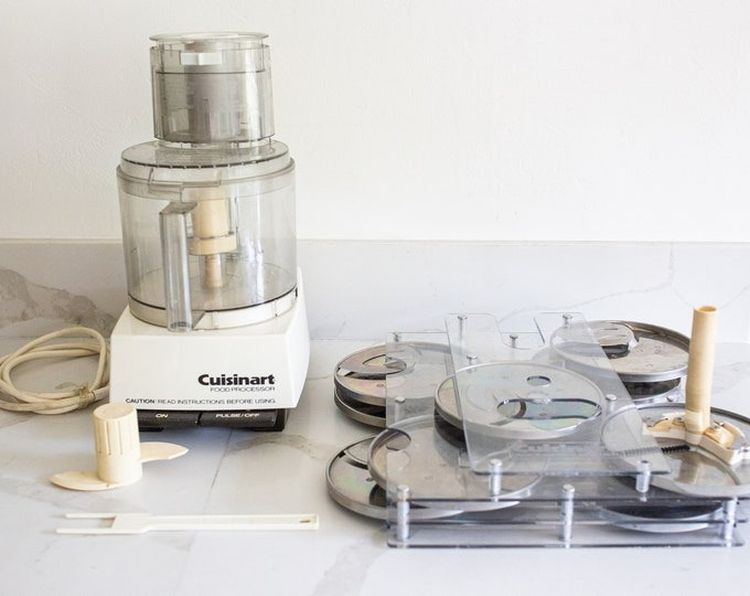
Performing the work of three sous chefs simultaneously, the Food Processor revolutionized home cooking when it entered American kitchens in the early 1970s. This culinary breakthrough swiftly handled chopping, blending, and mixing tasks that previously required considerable time and knife skills.
The first widely available model, the Cuisinart, debuted at a steep $175 ($1,050 today) in 1973 but quickly found its audience among serious home cooks. With sharp blades and adjustable settings, it allowed for uniform blends or precise chopping impossible to achieve by hand with such speed.
Using a Food Processor was like suddenly gaining culinary superpowers – tasks that once took twenty minutes now finished in mere seconds.
This essential kitchen companion simplified labor-intensive tasks like chopping vegetables, grinding nuts, and kneading dough. Julia Child famously endorsed the Cuisinart on her cooking show, helping to establish the food processor as a must-have appliance for anyone serious about cooking. Its versatility and efficiency laid the groundwork for our current era of kitchen gadgetry.
5. Cathode Ray Tube (CRT) TV (1950s-2000s)

If you grew up before the 2000s, the hefty Cathode Ray Tube TV served as your family’s entertainment centerpiece, weighing up to 100 pounds and requiring a dedicated corner of the living room. Early color models cost up to $500 ($5,000 today)—often requiring payment plans.
These bulky devices relied on vacuum tube technology that produced both warm-up time and that satisfying static “pop” when turned off. CRTs needed warming up like a reluctant teenager on Monday morning – slow to start but eventually functional.
Families gathered around these televisions for everything from moon landings to sitcoms. During the final episode of MAS*H in 1983, about 105 million Americans watched simultaneously – nearly half the country clustered around these glowing boxes.
4. Eight-Track Player (1965-1982)

Selling an astonishing 65 million units during their heyday, Eight-Track Players dominated American audio despite their notorious habit of switching tracks mid-song. These distinctive audio devices became fixtures in cars and homes during the 1970s, priced from $29.95 for basic models to $199.95 for premium systems ($300-$1,800 today).
Their continuous-loop design provided uninterrupted listening, though tracks often switched abruptly mid-song. Tapes required flipping to hear complete albums.
The technology operated like a musical highway with predetermined exits – once on a track, you stayed there until the next junction.
Despite being replaced by cassettes and CDs, eight-track players found new life among collectors. Working units now fetch $200-$500. Not bad for technology that frequently ate tapes and inspired colorful language from frustrated users.
3. VHS Recorder (1977-early 2000s)
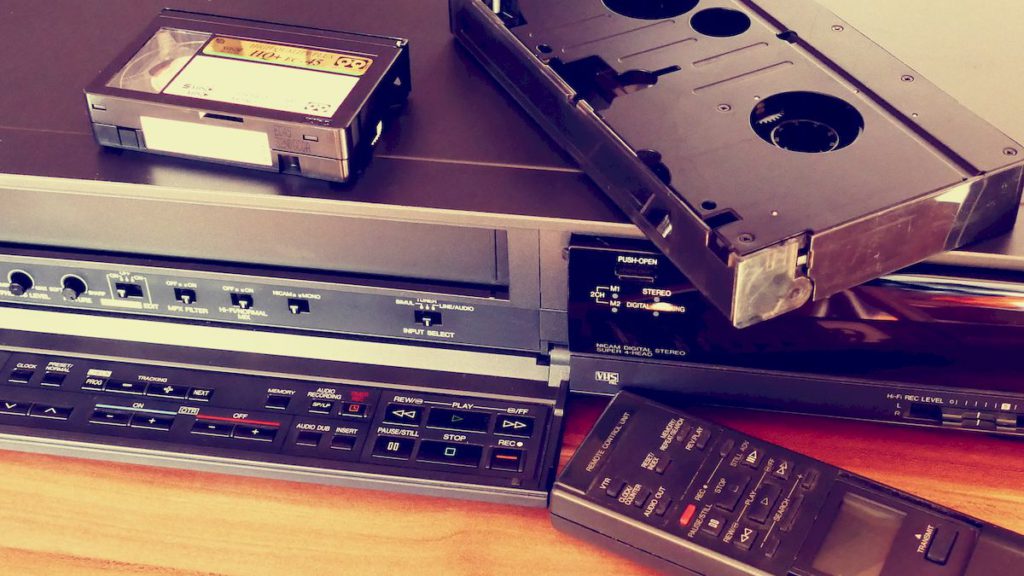
Missing your favorite TV show became a problem of the past with the VHS Recorder, which allowed viewers to time-shift programming and build personal libraries for the first time in media history. Early models cost between $1,000-$1,400 ($4,500-$6,300 today), making them luxury items for early adopters.
The ability to time-shift television viewing fundamentally changed media consumption. With one button, you preserved favorite programs and created personal libraries available on demand.
Programming a VHS required the precision of a safe-cracker and the patience of a saint. The blinking “12:00” became a universal symbol of technological defeat.
The format dominated home video for nearly two decades. Who remembers the strict “be kind, rewind” etiquette of rental shops? Or the disappointment of finding someone had recorded over your favorite show? (Still bitter about missing the “Dallas” finale.)
2. Rotary Phone (1950s-1980s)
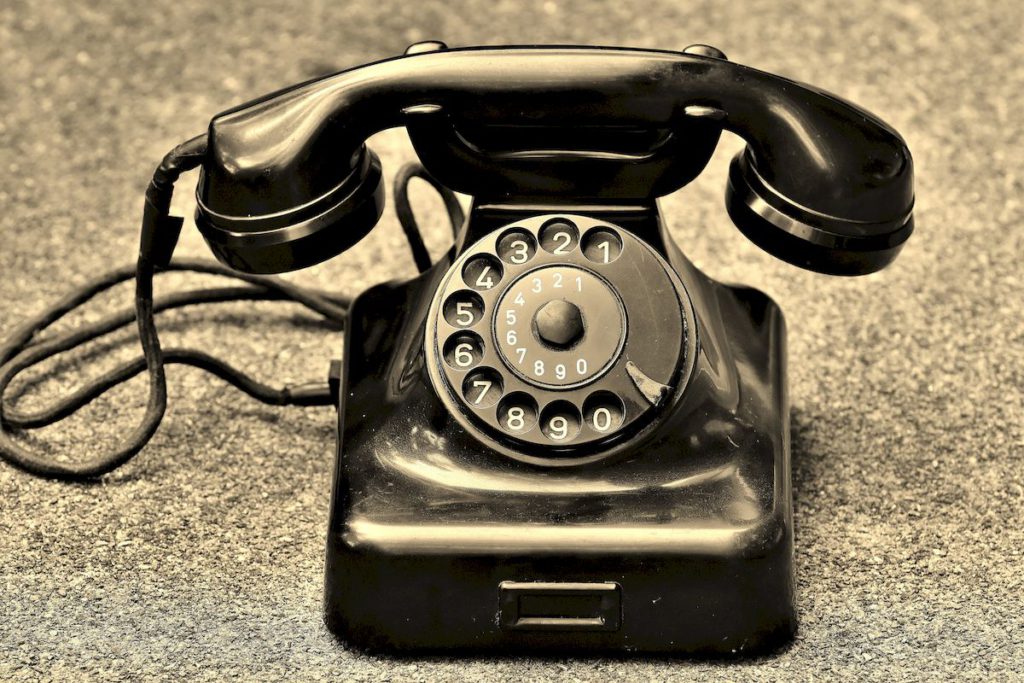
Before instant communication, the Rotary Phone connected people through a deliberate, physical dialing ritual that created a meaningful pause before each conversation. These sturdy communication devices defined telecommunication for decades with their distinctive circular dial and mechanical clicking sound.
Priced at $15-$45 ($150-$450 today) depending on style and features, most Americans rented rather than owned their phones from the Bell System until the 1982 breakup of the telephone monopoly. The unmistakable ringing and satisfying click of connection announced important calls from distant loved ones.
Dialing a rotary phone required about the same patience as waiting for a soufflé to rise – a test of character that today’s instant gratification culture has largely forgotten.
These phones were built like tanks – dropped, stepped on, even submerged in water, they’d often still work perfectly. Stories abound of rotary phones functioning after disasters that knocked out more sophisticated systems. Modern technology may be smarter, but nothing matches the satisfying tactile experience of spinning that dial to reach someone important. If you’re enjoying reading about these appliances from way back when, perhaps a more current look into the world of home & kitchen appliances might be refreshing.
1. Radar Range (1970s)

Transforming meal preparation time by a factor of ten, the Radar Range introduced microwave cooking to American homes during the 1970s when time-saving appliances were revolutionizing domestic life. This pioneering microwave oven stood out as a futuristic marvel in kitchens accustomed to conventional cooking methods.
Priced between $495-$595 ($2,800-$3,400 today), early models were substantial investments that promised to fundamentally change how families approached daily meals. The rapid defrosting, reheating, and cooking capabilities streamlined kitchen tasks in ways previously unimaginable.
Using a Radar Range felt like stepping into an episode of “The Jetsons” – science fiction made real in your kitchen.
Despite initial skepticism (and concerns about radiation), these devices quickly gained acceptance. By the late 1970s, an estimated 25% of American households owned a microwave, with adoption rates climbing steadily as prices decreased. The name “Radar Range” gradually gave way to “microwave oven,” but its impact on cooking convenience remains undiminished.




























